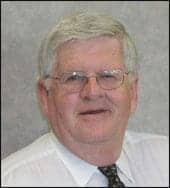 |
| David Harrington, PhD |
 |
| Michael R. Kauffman, CBET |
 |
| Wayne Hibbs, CCE |
 |
| Matthew F. Baretich, PE, PhD |
 |
| Ken Olbrish, MSBE |
 |
| Barbara L. Christe, MS |
Tumultuous times can lead to changes that may vastly improve an organization. Companies that don’t have the luxury of waiting out a storm find themselves compelled to take action in order to stay in the game. Our world faces those times now, and no one can deny that tough times have spread through most businesses. However, job boards and articles tout health care as the recession-proof industry. Yet, speak to any clinical/biomedical engineering department and it becomes evident that threats of outsourcing, layoffs, and restricted budgets have hit health care too. In these difficult times, what can the profession do to survive and emerge stronger? 24×7 asked members of its editorial advisory board for their views on the compelling needs of the industry now. Each has his/her own specific ideas, but meaningful standards, efficient interface, and expanded training ring out consistently.
“I recently saw a 1955 National Electrical Code book in a hospital,” says David Harrington, PhD, health care consultant, Medway, Mass. “It had nothing in it on health care, but there it was in a hospital.”
Harrington sees that 1955 publication as emblematic of an occupation where too many people seem to be traveling along different tracks. The result is bureaucratic mismanagement and a system that does not encourage greater efficiency. Where might the incentive to eliminate waste come from? “If Medicare, for example, said, ‘Everybody’s going to do it like this,’ it would get done, because they’d be paying 70% of the medical bills,” he says.
For Harrington, the most compelling need of the profession is to get everyone on the same page when it comes to requirements for equipment. “Every hospital and inspector needs to throw out all their code books that are more than 3 years old,” he says. “As an industry, we have spent billions on unnecessary technology—isolated power systems, conductive floors, air changes that do not take into consideration filters, and on and on. We have spent untold billions on useless PMs and on testing devices where such tests are not needed, and not done them on devices where they are needed because of some ‘requirement’ from The Joint Commission or another group.”
Harrington believes that in too many instances the profession has not taken enough responsibility for its own standards. “As a profession, we have allowed manufacturers to deny us testing software, spare parts, and training on devices that they sell us because they are hiding behind an old law,” he says. “And we have allowed nontechnical and nonmedical personnel—insurance companies and lawyers—who put the safety of the patient way down the list of priorities to set what our rules of care are. We need one set of requirements that everyone follows.”
Standards Mean Savings
Michael R. Kauffman, CBET, assistant director of facilities, Reading Hospital and Medical Center, Reading, Pa, echoes Harrington’s call for uniformity. “If we could establish some commonality in work practices we could probably reduce costs by not wasting our time doing things that we all know we probably shouldn’t have to do—but no one can agree that we shouldn’t have to do them,” Kauffman says.
The biomed team at Reading operates under a longtime system of optimal economic efficiency combined with the highest safety standards. Still, it is no surprise that in Kauffman’s nearly 3 decades in this field, he has never seen budget constraints this tight. Present economic realities make it difficult to justify inefficient procedures at those institutions where hours and dollars may have routinely been wasted on needless testing.
“At some places,” Kauffman says, “infusion pumps are inspected three times a year, other people do them twice a year, and at still others, like here, we do them once a year. Why can’t we all agree that pumps should be inspected [for example] every 18 months? And only a certain percentage—say, 10% of them in a facility—need be checked. If those 10% don’t fail, then you know the other 90% can be assumed not to fail.”
Kauffman realizes, of course, that it is not up to the individual biomed to make that call. In fact, it is a commonality of goals, perhaps through the combined impact of the larger medical establishments biomeds work with, that could best result in the desired unity of practice. Kauffman suggests the profession might capitalize on the inherent power of the country’s preeminent hospitals deciding to advance sound clinical/biomedical engineering procedures.
“If 20 of the nation’s largest medical centers decide they will work together to reduce their workload by adopting more efficient testing procedures,” Kauffman says, “then when The Joint Commission comes you can say, ‘It isn’t anything we made up ourselves. The Cleveland Clinic, UCLA, and these others (for example) have all adopted the same practices.’ And the more effective standards can start to be established.”
Wayne Hibbs, CCE, president, LifeStructures Technology Planning, Indianapolis, believes financial responsibility will become more apparent when “the professional staff of clinical engineering and biomedical technology develop a better understanding of the financial justification of the equipment they support,” Hibbs says. “Whether that is extending the lifetime of a technology through upgrades and relocation, or documentation of end of lifetime when upgrades and support are more expensive than replacement. Examples could be medical telemetry and infusion pumps.”
As Matthew F. Baretich, PE, PhD, president, Baretich Engineering, Fort Collins, Colo, sees it, some biomeds routinely do the same kind of testing simply because it aligns with the supreme mantra of uncreativity: “That’s the way we’ve always done it.”
“In these economic times, we don’t have that luxury,” Baretich says. “We need to be smart about where we use our resources. If we waste resources doing maintenance, then they can’t be used somewhere else. Start doing what really works, and we can move beyond a kind of defensive medicine that always has one eye on the threat of litigation toward proactively helping people.”
Baretich offers the amount of electrical safety testing done as an example of needlessly spent biomed hours. “Making sure that medical devices won’t cause an electrical shock is certainly a worthy objective,” Baretich says. “But the data I’ve seen shows that people do thousands and thousands of those tests and rarely find anything wrong. The equipment has improved so much in recent years. There are times when testing is appropriate, but most of the time it’s not, in my opinion.”
Baretich supports sound judgment and common sense, and advocates a solution based on evidence. “The solution is evidence-based maintenance,” he says. Baretich has good reason to value the things that really work. He consults with troubled hospitals, among others, and he knows the practical benefits of biomeds spending their time and energy on things that evidence indicates there is some benefit for doing. Baretich’s argument: “We’ve got a lot of data from decades of testing. We need to look at the data and learn what works.”
Facing the Interface Challenge
People so often use the adjective “compelling” these days that it can be difficult to figure out when they really mean it. That is not the case when Ken Olbrish, MSBE, enterprise imaging system administrator, Main Line Health System, Berwyn, Pa, says, “The most compelling need seems to be how biomeds address the evolution of stand-alone medical devices into networked and interfaced computers or information systems. First, biomeds are now sharing support responsibilities with IT professionals who may or may not understand the clinical significance of the medical devices on a hospital network. This presents potential turf wars and possibly delays in support or diminished support if responsibilities are not shared effectively. Ultimately, the clinicians and even the patients may suffer if shared support responsibilities are not effectively addressed.”
Kauffman’s call for comprehensive commonality reverberates through Olbrish’s discussion of missing interface standards. “There are clinicians asking to have many of these medical devices interfaced to share information, but there is a lack of standards to accomplish this task,” Olbrish says. “Or, vendors are still in their infancies in learning how to effectively interface their devices and share their clinical data with other devices and systems. This places a strain on biomeds asked to help bring about integration between devices when the vendors are not yet ready to do so.”
More and more, IT technology is being incorporated into medical devices, and the trend will continue to provide new ways to use equipment. Smart infusion pumps are one example where the expansion of wireless technologies has made it easier to pass information from bedside medical devices back to centralized monitors or information systems. “From this standpoint,” Olbrish says, “I think that the general advances in IT technology will ultimately lead to improvements in medical device technology. However, I will say that there is a definite need to continue to address standardization of medical devices and systems, and interfaces between them.
“If you look at EMRs right now, there are dozens of vendors who sell EMRs and there are dozens of ways in which vendors of these systems share information,” Olbrish continues. “As a result, health care facilities must spend considerable time and money to try to get all the data they need into their EMR. The recent government stimulus package offers tremendous potential for health care facilities and physician offices to obtain EMRs, but at present it doesn’t offer any plans for trying to standardize the rollout and integration of EMRs.”
Olbrish sees many benefits if biomeds and IT staffs forsake jealousy, avoid turf wars, and effectively share responsibilities—even if it won’t be easy. “As biomeds and hospital IT staffs work more closely together, there are opportunities for biomeds to learn from their IT counterparts,” he says. “Biomeds may not have had any significant IT training but are now being asked to provide some level of IT support for these networked medical devices. Biomeds should provide justification for the IT training that they require to support medical equipment on a day-to-day basis. Having knowledgeable biomeds is perhaps the easiest way to begin to address these issues, and it is something within control of biomeds themselves.”
The Next Generation
It is not surprising that an educator like Barbara L. Christe, MS, program director, biomedical engineering technology, associate professor, engineering technology department, Indiana University Purdue University Indianapolis, also views collaboration as a key to effective integration of data from devices and patient records. To work smoothly, Christe says, “It’s going to take some innovation, creativity, and partnership.” Oftentimes, the clinical/biomedical engineering—IT partnership involves implementing technology that has actually been around a while. “It’s the spirit of collaboration that the active participants aren’t used to,” Christe says. As a professor, however, Christe’s most immediate concern is the growing scarcity of qualified biomeds to fill the available places in the nation’s health care system.
As Christe explains, the various branches of the country’s military provided the first formalized BMET training. That began in the 1940s—before American institutions of higher education got into the mix—and hospitals were more than happy to employ such well-trained BMETs when service personnel began to retire from the armed forces.
Now, however, the armed forces do not produce as many trained BMETs. Sheppard Air Force Base in Texas has the military’s only current training operation. And the original BMETs who took their well-honed skills from military to civilian medicine? They’re beginning to retire from the civilian work force. “That leaves a gap that’s just not being filled,” Christe says.
Christe, director of one of the nation’s earliest and most prominent college biomedical engineering technology programs (Purdue’s began in the early 1970s), has concerns about that gap. “There are about 28 biomed programs around the country,” she says. More are needed.
Christe often gets phone calls from across the country—she had just answered one from Arizona—from prospective students inquiring about the Purdue program. She is happy to discuss the field with potential future BMETs, but realizes most young people are not interested in attending a program thousands of miles from their home. Many more students would be entering the profession if their community colleges made biomedical engineering training available.
What about the possibilities for school programs online? “Totally online isn’t quite there yet,” Christe says. “Until we can use high-level technology to help students experience the hands-on activities virtually, which I do believe is possible, students cannot experience the entire curriculum at a distance. The problem is that universities and colleges don’t have a strong incentive to invest in the technology required to support distance learning about medical equipment, so I think it will be a while.”
Touching on longtime academic realities not helped by current economics, she says, “Higher education is usually pretty slow to respond when high-dollar investments are required. In addition, our out-of-state tuition is so high, students who live far away are unlikely to want to pay the huge dollar amounts required to earn a degree at a distance.”
Going Forward Together
From at least some perspectives, the collaboration that technological advances promise seems blocked by a lack of strong unity within the profession. “Our profession has got to get off their you-know-whats, start talking to people, and say, ‘This is how we’re going to save money,’ because right now everybody’s working in a vacuum,” Harrington says. For a profession in which thousands of members make voluntary worldwide treks to improve conditions where health care systems do not even exist, that would seem achievable.
David Tandet is a contributing writer for 24×7. For more information, contact .
A Technology Wish List
There is no question that technology makes the jobs that clinical engineers and biomedical equipment technicians perform easier, but it does not always meet all the users’ needs. Do you see the potential for improving a technology in use? Or do you envision a new way to restructure your work that creates a more efficient use of time and conserves precious dollars? In line with asking what the profession needs now, 24×7 also put the technology topic before its board asking: What new technology would you like to see? Some responded with specific device ideas, while others, like Michael R. Kauffman, CBET, assistant director of facilities, Reading Hospital and Medical Center, Reading, Pa, said he simply wants to see “anything that saves money. Real money—not cost avoidance.”
Ultimately, it seems most agree that nothing new really matters if the profession doesn’t get on the same page with unified standards and practices. It’s all about saving money and putting patients’ needs first. According to Matthew F. Baretich, PE, PhD, president, Baretich Engineering, Fort Collins, Colo, it is not so much about a new product or technology here or there, but simply about what works and saves money.
Ken Olbrish, MSBE, enterprise imaging system administrator, Main Line Health System, Berwyn, Pa, focused his wish list on improved standardization—with devices, systems, and interfaces among them. Speaking on the topic of EMRs, he adds that without any specific plans in place for trying to standardize the rollout and integration of EMRs, the potential exists for an increase in “significant support issues and/or costs over time due to the amount of customization needed to integrate all these different systems without any standardization. Therefore, improved standardization offers the biggest potential for the medical device and health care IT industry.”
David Harrington, PhD, health care consultant, Medway, Mass, proffered quite a list, based on projects he previously worked on. What would he like to see? “Simple items that I worked on in the past, such as an infusion pump that changes dosage as the patient’s condition changes. I worked on that in 1971 before PCs. The size of the pump was very large, noisy, and impacted the nurses’ movement around the patient’s bed,” Harrington says. “The last I heard, several companies are doing trials on this type of product in the animal labs, which means it’s about 3 years away from human use. Because this technology was described before 1976, it does not have to go through the FDA—but there is a movement to remove the ‘grandfathering’ of devices.”
Other devices he would like to see that he had a hand in include “a patient monitor that sets all parameters by itself with no human involvement and changes as the patient’s condition changes. That was in 1983, but resistance from risk managers is making this difficult to get into clinical use. The technology is present on most monitors but not enabled at this time. From 1989, all equipment interconnected to automatic medical records—now a hot topic; and automatic exposure on CTs so patients are not overdosed, from 2003. This is now on many of the CTs as they are starting to market them into nontraditional areas where radiologists are not controlling the machines, such as cardiac, virtual colonoscopy, and sinus tests. Only one holdout still from manufacturers on allowing for exposure settings, and I hear that they will be offering it soon.”
Wayne Hibbs, CCE, president, LifeStructures Technology Planning, Indianapolis, has his eye on a current technology that he would like to see upgraded for medical use. “Airports are now beginning to use a whole body x-ray scanner that has been criticized because it is too revealing for public screening,” he says. “This is a low-energy unit that shows 3D body contours, but does not penetrate to review bones, etc. I would like to see a medical-grade unit for emergency department trauma that shows broken bones, internal bleeding, and tumors that would be read by an computer-assisted diagnostic scanner as currently used for mammograms and chest films. This could provide rapid diagnostic information and universal health care review for undiagnosed ailments.”



